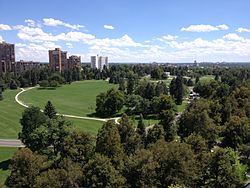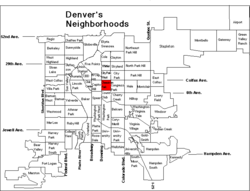Cheesman Park, Denver
|
Cheesman Park
|
|

Looking across the main lawn from the northwest corner.
|
|

Cheesman Park highlighted on a map of Denver's neighborhoods.
|
|
| Location | Roughly bounded by E. Thirteenth Ave., High St., E. Eighth Ave., and Franklin St., Denver, Colorado |
|---|---|
| Coordinates | 39°43′58″N 104°57′57″W / 39.73278°N 104.96583°WCoordinates: 39°43′58″N 104°57′57″W / 39.73278°N 104.96583°W |
| Area | 80.7 acres (32.7 ha) |
| Built | 1898 |
| Architect | Reinhard Schuetze, Marean & Norton |
| Architectural style | Classical Revival, Mission/Spanish Revival |
| MPS | Denver Park and Parkway System TR |
| NRHP Reference # | 86002221 |
| CSRHP # | 5DV.5308 |
| Added to NRHP | September 17, 1986 |
Cheesman Park is an urban park and neighborhood located in the City and County of Denver, Colorado, United States.
Cheesman Park is located in central Denver, southeast of downtown. The Park has inexact borders, as it is framed on 3 sides by private residences, but is located in center of the Cheesman Park neighborhood, between Humboldt Street on the west, Race Street and Denver Botanic Gardens on the east, 13th Avenue on the north, and 8th Avenue on the south. The neighborhood's borders are approximately:
In the late 19th century, the land that is now Cheesman Park was Prospect Hill Cemetery, which also included the land that is now the Denver Botanical Garden and Congress Park further east. The long-disused cemetery was converted to a park which opened in 1907, after city planners felt it would provide an amenity to new residents as land development moved east of the central city. The park was originally named for the US Congress who gave permission to change the cemetery to a park and was renamed Cheesman Park in honor of Denver pioneer Walter Cheesman whose family donated the funds for the neoclassical pavilion on the eastern side of the park in his honor shortly after his death.
The cemetery opened in 1858 and the first burial occurred the following year. In 1872, the U.S. Government determined that the property upon which the cemetery sat was actually federal land, having been deeded to the government in 1860 by a treaty with the Arapaho. The government then offered the land to the City of Denver who purchased it for $200. Although today it is still mostly remembered as Mt. Prospect Cemetery, in 1873 the cemetery’s name was changed to the Denver City Cemetery.
As time went on different areas of the cemetery were designated for different religions, ethnic groups and fraternal organizations such as Odd Fellows, Society of Masons, Roman Catholics, Jewish, the Grand Army of the Republic, and a segregated section at the south end for the Chinese. Some sections were well maintained by family descendants or their organizations, but others were terribly neglected. In 1875, 20 acres (81,000 m2) at the northeast part of the cemetery (slightly east of where the botanic gardens are now located) were sold to the Hebrew Burial Society, who then maintained it, while much of the rest of the graveyard fell further into disrepair. By the late 1880s the cemetery was rarely used and in great disrepair, becoming an eyesore in what had become one of the most exclusive parts of the quickly growing city. Real estate developers soon began to lobby for a park to be in its place, rather than an unused cemetery. Before long, Colorado Senator Henry Moore Teller persuaded the U.S. Congress to allow the old graveyard to be converted to a park. On January 25, 1890, Congress authorized the city to vacate Mt. Prospect Cemetery and in recognition, Teller renamed the area Congress Park.
...
Wikipedia
